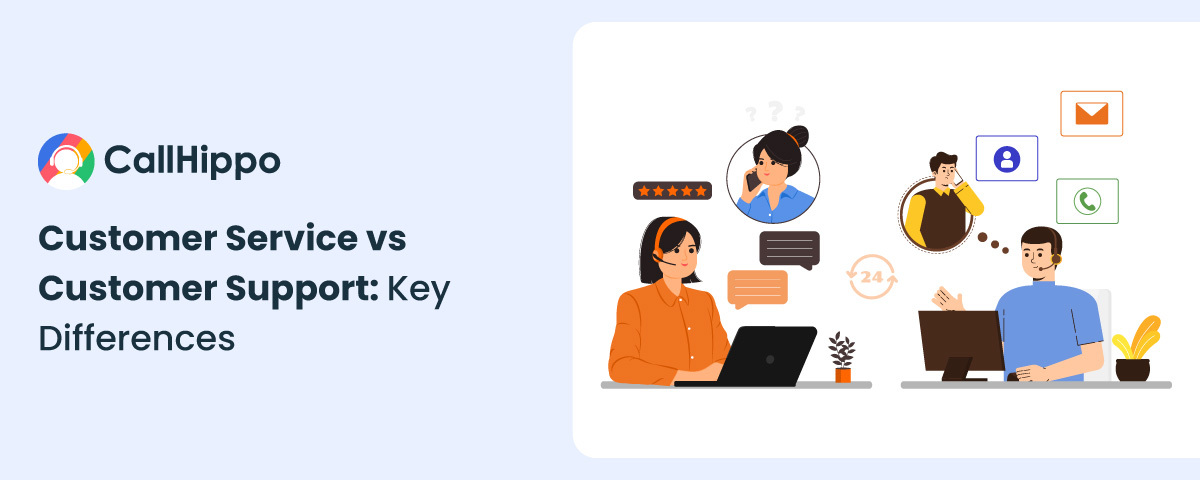There is often confusion between customer service vs. customer support. Despite these subtle distinctions, both seek to optimize the value that consumers receive from a good or service. But their purposes and means of support are different.
Organizations need to understand these distinctions to allocate staff departments, distribute resources efficiently, and improve customer satisfaction. The differences between the customer service team and the customer support team are discussed in this article, along with tips to improve the customer experience.
What Is Customer Service?
Customer service is a comprehensive process that involves supporting clients throughout their entire journey with a product or service. It’s important to emphasize that ensuring exceptional customer service, addressing requests, resolving issues, and optimizing the product’s value for customers is a shared responsibility among all teams within a company.

It involves a number of strategies to improve the customer experience, like having customer service agents assist in selecting products, respond to questions both before and after the sale, settle billing disputes, and do other duties that come into contact with customers. Customer service deals with ensuring that consumers are happy with all of their encounters with the business.
Understanding the subtle differences between customer service and support is crucial for effective strategies. While service covers overall interactions, support focuses on product issues.
Align staff and resources accordingly for optimal customer satisfaction and long-term relationships.
What Is Customer Support?
Customer support is a process of helping clients with inquiries and problems. This includes responding to inquiries promptly and helpfully, assisting clients with the onboarding process, addressing technical issues, and guaranteeing smooth upgrades to new goods or services.

Customer support teams primarily focus on handling specific issues that may arise with a business’s goods or services. When a product malfunctions or customers have queries about recent purchases, they typically reach out to customer support. The key role of customer support is to provide immediate and effective solutions, instilling confidence in the customers about the support system.
What Is The Difference Between Customer Service and Customer Support?
The difference between customer support and customer service teams lies in their focus. The focus of both customer service and customer support teams differs: the former helps with product-related problems, while the latter attends to the needs of the client.
Here’s a table highlighting the nuanced roles and responsibilities of customer service vs. customer support, emphasizing their distinct functions within an organization:
| Aspect | Customer Service | Customer Support |
|---|---|---|
| Who | Provided by various roles such as sales reps, account managers, and support staff | Delivered by specialized teams with technical expertise |
| What | Focuses on assisting customers with specific issues or queries | |
| Where | Offered through similar channels, including dedicated support lines | |
| When | Needed when customers face specific challenges or problems | |
| Why | Targets immediate resolution of customer issues or concerns | |
| How | Primarily reactive, solving problems and providing personalized solutions | |
| Job Nature | Offers various growth opportunities, including technical and managerial roles | |
| Focus | Enhancing customer experience through technical problem-solving | |
| Metrics | Also looks at broader metrics like NPS, CES, and churn | |
| Industry | Predominantly in tech industries like SaaS, IT, and e-commerce | |
| Problem-solving | Involves technical troubleshooting and developing new solutions | |
| Approach | Reactive, addressing existing problems | |
| Customer Journey | Intervenes during specific issues in the customer journey | |
| Company Presence | Mainly found in technology and equipment-related companies | |
| Knowledge Level | Deep technical knowledge of products and services | |
| Interaction Type | Transactional, with clear goals to resolve specific issues |
Tips For Great Customer Service And Support
Although AI can help clients discover the answers they need fast through chatbots and knowledge libraries, excellent customer service goes beyond individual efficiencies. The following are some insightful pointers for delivering great customer service and support:

1. Provide the Teams With The Necessary Equipment
Choose hardware or software that improves the team’s capacity to deliver the greatest experience. For instance, a service that enables screen sharing or customer interactions with the customer’s screen can be necessary for a customer care staff that works with complex software. A user database can also assist employees in effectively managing information and resolving problems.
2. Hire for Key Qualities And Skills
Roles involving clients call for specific traits. When hiring, make sure the customer support agent has qualities like emotional intelligence, empathy, patience, and troubleshooting skills.
3. Engage In Active Listening
Teach your employees to listen intently when you receive feedback from customers. Customers will see this as a sign that their experience is appreciated and that operations for support and service may be improved based on their comments.
With CallHippo
- Sentiment Analysis
- Talk-to-Listen Ratio
- Call Performance Rating

4. Offer Proactive Assistance
Analyze and resolve consumer inquiries and obstacles by leveraging data and analytics. To ensure customer loyalty, provide them with timely messages about known concerns, contextual tooltips, and simple onboarding.
With this proactive strategy, the emphasis is shifted from reaction to prevention, enabling consumers to either completely avoid or address minor concerns on their own.
5. Invest in Training and Quality Assurance
Excellent service begins with a competent team. Invest in quality control and specialized instruction to help your team become more adept at handling challenging inquiries. Employers should select candidates based on specific needs to enhance existing employees and provide superior customer service.
6. Pay Attention to Client Feedback
Understanding what customers have to say is essential to providing exceptional service. Gather input from customers via surveys, reviews, and other channels using the Voice of the Customer (VoC).
By examining this input, customer support agents can better understand your customers’ objectives, demands, and problems and adjust support and services as necessary.
7. Promote Self-Service By Customers
Give consumers the opportunity to research issues on their own by utilizing chatbots driven by AI and combined with an extensive knowledge library.
Chatbots can respond to user inquiries by providing pertinent data from the knowledge base, have a conversational response, and, if required, escalate to a human representative.
Conclusion
Understanding the subtle difference between customer service and support is essential to creating plans that address client concerns and foster enduring connections.
While customer support focuses exclusively on resolving problems with products or services, customer service skills encompass all contacts a firm has with its consumers. So, in the debate between customer service vs. support, both are essential to providing a remarkable customer journey and experience.
FAQs
1. What is the difference between customer service and user support?
Customer service focuses on overall customer experience, while user support addresses specific product or service issues. Both are vital for ensuring customer satisfaction and fostering long-term relationships.
2. What is the difference between a customer service representative and a customer support specialist?
A customer service representative focuses on the overall customer experience, while a customer support specialist addresses specific product or service customer inquiries, both crucial for maintaining customer satisfaction.
3. What qualifies as customer service?
Customer service encompasses all interactions and support provided by a business to meet customers’ needs, ensure satisfaction, and enhance their overall experience with the company’s products or services.
4. What are the 5 skills of customer service?
The 5 skills of customer service are:
- Empathy
- Problem-solving
- Communication
- Active listening
- Technical knowledge

Subscribe to our newsletter & never miss our latest news and promotions.









